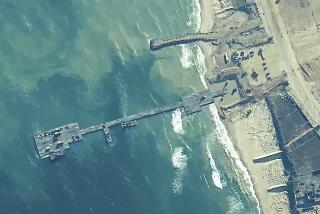Relief Workers Look to Somalia’s Future : Mission: Aid agencies hope international community will help rebuild nation.
WASHINGTON — U.S.-led troops landing in Somalia will find international relief officials already focusing on that nation’s long-term needs even while rushing food to the famished millions.
Relief workers, in interviews conducted since President Bush’s announcement Friday of military intervention, expressed hope that the international community will look beyond delivery of food and other immediate aid and help begin rebuilding the nation. They also voiced concerns that U.S. troops are likely to suffer casualties and may be traumatized by the suffering they will encounter.
Dreading that chaos will return after Operation Restore Hope ends, relief workers are racing to help farmers plant corn, hoping to avert what one called “yet another cycle of agricultural dependency.”
Toward that end, relief workers also are helping Somalis restore abandoned irrigation canals and damaged drinking wells, rebuild homes and hospitals, and regenerate a once-thriving trade in livestock--a major Somali export to the Middle East.
“We’ve got to get people out of the dependence mode and into a production mode,” Barrett Baron, vice president for international programs at Save the Children, said Saturday. “Unless this underpinning is done, there can be no long-term solution.”
While the living conditions are likely to begin improving immediately upon the troops’ arrival, Baron and other relief officials urged a longer view.
“The military certainly can provide a secure environment in which to deliver food,” Steve Tomlin, director of the Los Angeles-based International Medical Corps in Somalia, said in a Saturday telephone interview from the capital, Mogadishu. “But with a little extra thought, they can also enhance quality of relief that is delivered--for the long term.”
In conversations over the weekend with relief officials who are either in Somalia or have just left there, a consensus emerged that the international assistance effort is unlikely to progress as smoothly or end as quickly as many hope. Defense Secretary Dick Cheney said Friday that regular U.N. peacekeeping forces could begin replacing American soldiers before President Bush leaves office on Jan. 20 and that U.S. troops could be out a few weeks thereafter.
Baron and Willet Weeks, another Save the Children officer, said the 28,000 U.S. soldiers will not be nearly enough to establish more than just a few corridors for food deliveries to Somalia’s interior.
Weeks said it would take 7,000 soldiers just to ensure one such corridor from Mogadishu to the town of Baidoa, one of the worst areas of mass starvation.
With millions of Somalis subsisting miles from any such potential corridors, there may not be enough troops to secure many more such safe routes, according to Weeks, who has worked in Africa for more than 20 years.
Tomlin, who has been in Somalia for more than a year, said there are probably numerous as-yet-undiscovered pockets of mass starvation.
“We’ve gone essentially as far as the road can take us,” he said. “But there are whole areas with villages that are totally inaccessible to us because either the roads are just impossible or the conditions of the trucks are so poor that we cannot use them.”
Tomlin suggested that military helicopters could be used to scout out such areas.
As troops begin to move out from secured areas--stretching themselves thin in the process--they could become targets of hostile forces, others warned.
“There are so many people in Somalia running around with guns and weapons that there are bound to be incidents,” Baron said. “You’ll have trained teen-agers, who are armed, facing untrained teen-agers, who are armed.”
A likely result, he said, will be American casualties, which would lead to political pressures to end “this novel and noble adventure.”
But whatever the risk, relief officials said, getting troops into Somalia’s hinterlands quickly is vital. Farmers and their crops will need to be protected from marauders as next month’s harvest season approaches, according to Baron and Weeks. One such place is the lower Shabelle Valley of southern Somalia, where “pockets of relative peace and stability” have taken hold, thanks partly to recent rains that have allowed the planting of corn, Baron said.
Southern Somalia is the site of most of the nation’s famine because of a breakdown in order and the rise of clan warfare under the rule of Maj. Gen. Mohamed Siad Barre, a former president driven from the capital early last year. Conditions were exacerbated by several successive years of drought.
Relief officials also urged that attention be paid to the entire Horn of Africa because hundreds of thousands of Somali refugees have crossed into neighboring Ethiopia and Kenya.
Relief officials, speaking from personal experience, also worry that the soldiers of mercy could become traumatized by the searing images of starving men, women and children.
“No words are adequate to describe it,” said Ann Stingle, an American Red Cross official just back from Somalia. “I’ve heard people say they’ll never be the same again.
“Everyone feels so helpless--especially when the solution is so simple: These people just need to eat.”
More to Read
Sign up for Essential California
The most important California stories and recommendations in your inbox every morning.
You may occasionally receive promotional content from the Los Angeles Times.










